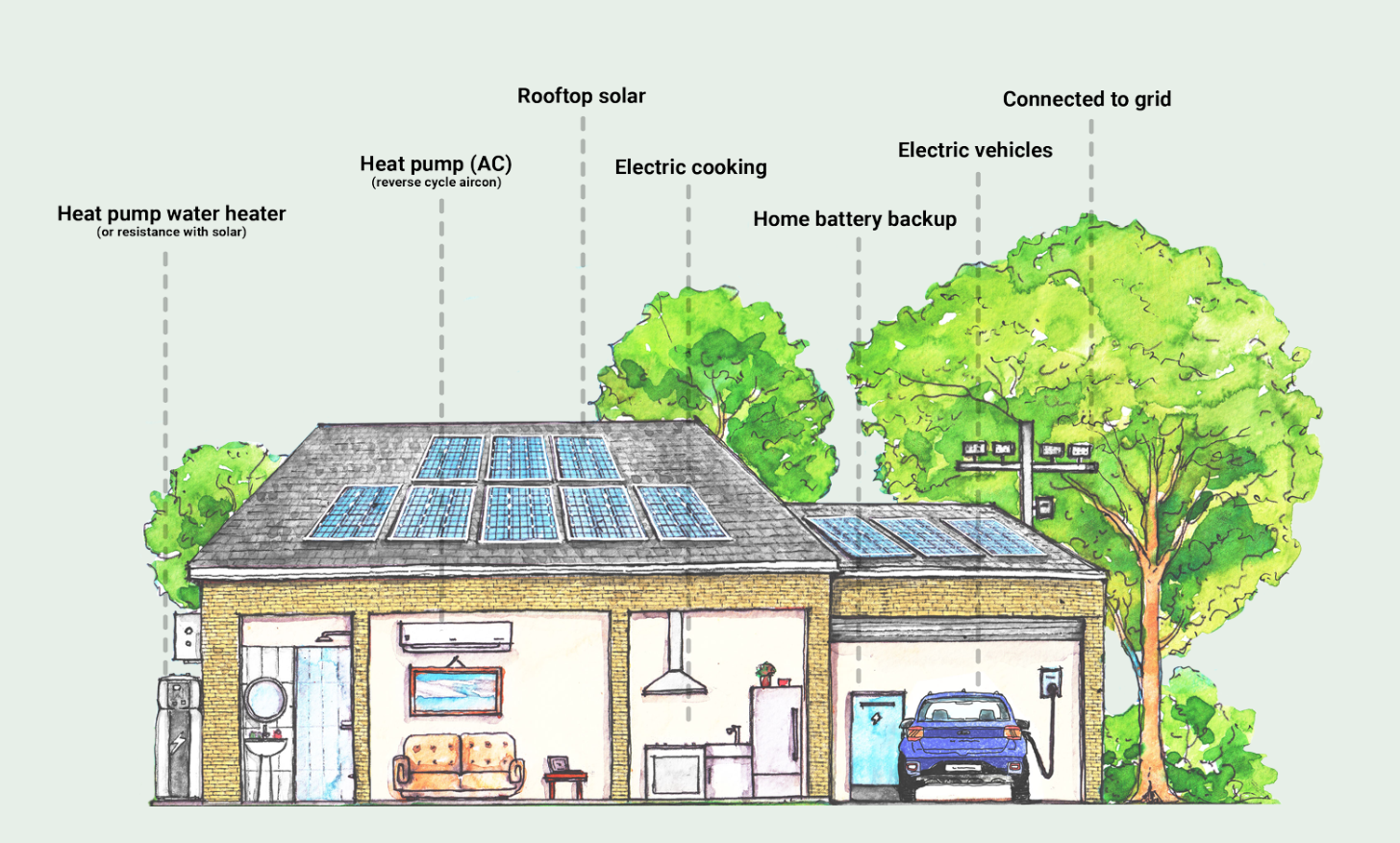Did you know that by electrifying our homes and businesses, we can reduce Te Ara Kairangi ki Tai Lower Hutt’s emissions and help achieve Aotearoa New Zealand’s emission reduction targets?
Electricity is already more than 87% renewable and it keeps getting better. Operational emissions for a home that relies on electricity for heating, cooking and hot water are typically 50% less than for a home that relies on fossil gas for those same tasks. Electric technologies are tried and tested, and what’s more, don’t necessarily cost more.
For example, heat pumps are already the most energy-efficient way to heat homes (on average, for every 1kW in, you get 3kW of heat energy out). This helps save money as well as carbon!
If you are planning a new home or new development, do get in touch for some free advice. Check out some questions and answers below for some further information.
Image via www.rewiring.nz
There are still a lot of households in Aotearoa New Zealand that burn fossil fuels for water-heating, space-heating, driving and cooking. An electric home swaps some or all of those fossil fuel machines for much more efficient electric equivalents and, if possible, adds solar panels to generate their own lowest-cost electricity and batteries to store that electricity for resilience (see above).
- Aotearoa New Zealand’s electricity production is already more than 87% renewable, which means that electricity is much lower-carbon than alternative options such as fossil gas.
- Using electricity for space and water heating is cost-effective. While heat pumps for space heating tend to be relatively costly upfront, their whole-of-life costs tends to be low compared to other technologies due to their high efficiency. Heat pumps maximise the efficiency when using electricity because they shift ambient heat from the air outdoors and transform each unit (kW) of electricity into three or more units of heat.
- With regards to commercial applications, cost-effectiveness and whole-of-life costs will depend on the particular application. EECA also has information on heat pumps for processing heat as a low-carbon and viable replacement for fossil-fuelled boilers for businesses.
- Avoid any potential health impacts from the use of fossil gas used for cooking.
- Avoid additional fixed lines charges for the use of fossil gas if your home no longer relies on any gas for space/water heating and cooking.
For a comprehensive overview on the benefits of going electric, check out Rewiring Aotearoa’s Electric Homes Report.
As organic material such as plants and animals decay underground over millions of years, they form bubbles of gas. There are different types of gases that form in this process, with different chemical makeups, which are then used in our daily lives.
The main two used in Aotearoa New Zealand are fossil gas (mainly methane, with smaller amounts of other gases such as propane) and LPG (liquified petroleum gas, a mix of propane and butane stored in a liquid state).
Fossil gas makes up 11% of Lower Hutt’s total emissions and about 34% of the city’s stationary energy emissions (heating and powering homes and businesses).
Fossil gas is used in homes and businesses throughout Te Awa Kairangi ki Tai Lower Hutt. Domestically, fossil gas is commonly used for hot water, cooking and heating, and about a third of all households in our city use fossil gas for some form of heating or cooking.
Biogas is produced from a range of raw materials, such as agricultural and food waste. So why not use this?
- Biogas is not currently readily available in Aotearoa, and it’s unlikely this will change in the next five-to-10 years. As it’s critical to halve emissions by 2030 to keep warming below 1.5C, we can’t afford to wait for biogas. Unfortunately, even if we did wait, forecasts show there is insufficient future supply to replace all fossil gas with biogas.
- Even though burning biogas is considered carbon neural, leakage of biogas from the gas network is a pollutant (>80% methane, which has 28x the warming potential to carbon dioxide) and would contribute to further warming.
- Biogas is best reserved for hard-to-electrify applications (eg high temperature heat requirements).
- Biogas and fossil gas have the same health impact in the home (gas stoves can leak methane, but cooking with gas also contributes to moisture load in the home).
- Gas stoves using fossil or biogas can leak about 1% of the methane they consume unburnt, normally while the stove is off. Cooking with fossil or biogas also releases chemicals that can cause inflammation in the airways – this has been linked to asthma in children. As noted by the National Asthma Council of Australia, cooking with gas can have higher health risk as it occurs indoors where it is likely that pollution cannot escape easily.
Hydrogen emits only water when burned, which is great. So why isn’t this a viable option for Lower Hutt?
- Hydrogen is not currently available in Aotearoa, and it’s unlikely this will change in the next five-to-10 years. As it’s critical to halve emissions by 2030 to keep warming below 1.5C, we can’t afford to wait for hydrogen.
- Hydrogen can be blended with fossil gas, and thus be used by existing gas technologies, but this is limited. For blends higher than 20%, appliances need to be replaced. This replacement would come at a significant cost, as hydrogen technologies are not common in the New Zealand market. It would be more cost and energy effective to replace with electricity.
- Creating hydrogen is very energy-intensive: 3 times more energy is needed for at home technologies to do the same work than is needed for using electric technologies (e.g. heating homes).
- Even if the combustion of hydrogen can be considered emissions-free, leakage of hydrogen is still problematic. While hydrogen is not a greenhouse gas, it does interact with other greenhouse gases and lengthens the lifetime of these gases.
- Hydrogen is best reserved for hard-to-electrify applications (e.g. high temperature heat requirements, some heavy transport).

